#I tend to use Japanese names and culture
Explore tagged Tumblr posts
Note
I'm sorry, this was bothering me enough to send in an ask.
The stupid question is: how strict is Earth-Kingdom-is-China vs Fire-Kingdom-is-Japan generally? I mostly ask because although none of the canon characters use real Japanese names, but it feels like everyone uses Japanese names for Fire Kingdom and Chinese for Earth, which makes Chinese Wanyi for Zuko's ship not fit in.
I mean, the waters are muddied from China's historical domination over the area, and it's a really great pun, but I woke up and my brain wouldn't let go of the entirely petty issue.
Ugh. Sorry for the stupid ask, especially since I don't come bearing any like funny trivia with to mitigate with. Please feel free to disregard as well, especially since I'm too cowardly to link to my actual tumblr account.
There's absolutely no strictness, because that's a fanon division anyway, and not one I adhere to. Fanon is fake and we can make of it what we want, and I want the pretty ship name!
#I tend to use Japanese names and culture#because I minored in Japanese and lived in Japan for awhile#I use Chinese and other Asian-country concepts as I become aware of them#the show itself deliberately mixes cultures across the board#probably because they realized making the Fire Nation == Japan would be#Uh#Rather on the nose#Historically speaking
525 notes
·
View notes
Text
didn't want to put this rant in the tags of that last post but honestly i feel like a lot of people hate toshiro disproportionately compared to what he actually did in-story. and if we're being real it's most likely because of racism
#xyx.txt#because so much of his misunderstanding of laios comes from a cultural angle#and because his mannerisms are strongly coded as japanese especially relative to the other characters in the story#i think a lot of people's implicit biases have them reading this as an inherent and unchangeable aspect of his being#rather than being just one aspect of him that originates from a particular context and is fully changeable#like any other trait on anyone else.#part of this is just because of the fact that the story is told from laios and his party's perspective#but i think a lot of people's perspectives on him are probably informed by racism#not all east asians are quiet and polite. i know this myself as a kind of loud and awkward and easily excited east asian person myself#but generally cultural mannerisms from east asia tend to be more subdued overall than western ones#so it's. not uncommon. for western people to read east asians as being rude or cold or aloof just for behaving like this#the 'oriental inscrutability' moment...#like he doesn't need to 'get rid of the stick up his ass'. he just needs to not put such heavy expectations on other people#but yeah i think a lot of people are way more unsympathetic to him than they would have been if he were not so distinctly asian-coded#which is ironic! a lot of people being really mad at him for ableism specifically in the social expectations he holds of others#while applying the same kind of judgment to him but through the perspective of race instead of neurodivergence. suspicious.#blah blah blah it's because he's 'neurotypical' or whatever#predicting how some of you people would behave toward neurodivergent asian people and the outlook isn't good#also if we're on the subject of microaggressions.#laios repeatedly and insistently calling him 'shuro' to the point that everyone else calls him that too#that's not 'funny autism bad with names' moment that's a racist microaggression#someone misnaming me because of my distinctly ethnic/foreign-sounding name doesn't automatically become funny and relatable#just because you're neurodivergent lol#can we maybe have more empathy toward characters and people of color in fandom#instead of always using them as punching bag side character trope#thanks.
12 notes
·
View notes
Text
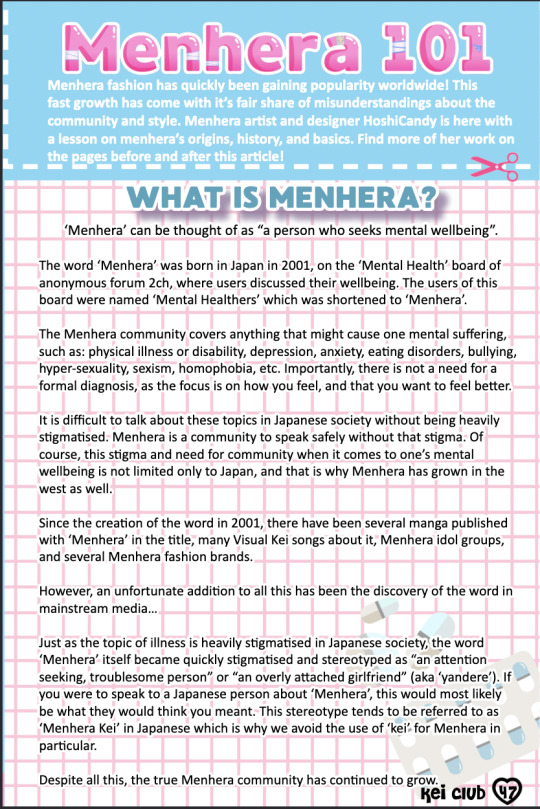
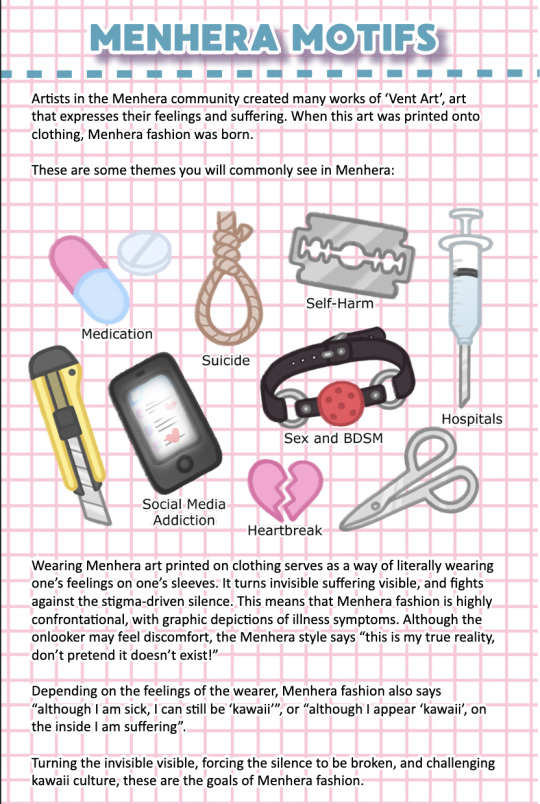
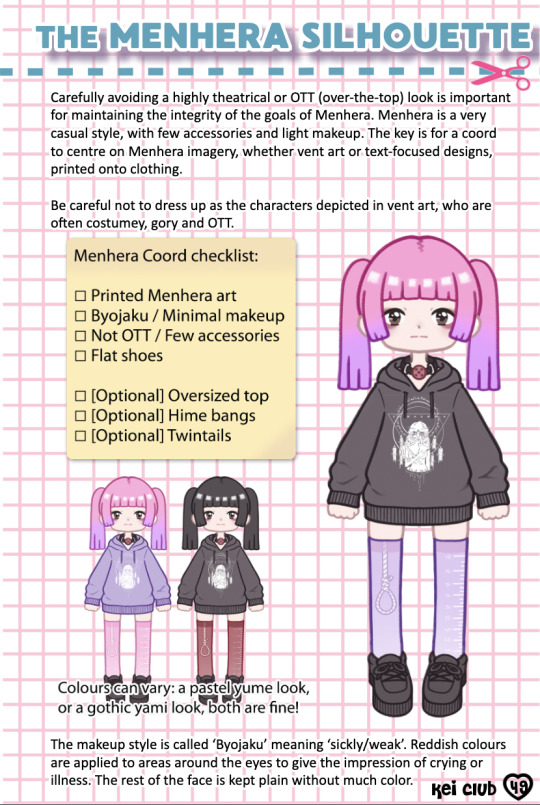

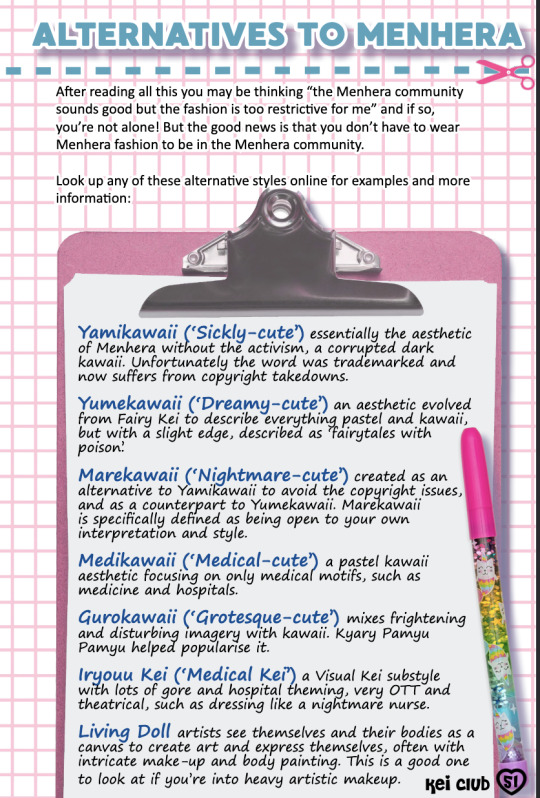
in case you haven't seen it yet, here's the menhera 101 article by HoshiCandy from Kei Club Issue 3. not sure if i'll post the other menhera related articles from this issue or not, so consider checking the link in source if you're interested.
i'm also leaving a text transcription under the cut for anyone that may benefit from that
Menhera 101
Menhera fashion has quickly been gaining popularity worldwide! This fast growth has come with its fair share of misunderstandings about the community and style. Menhera artist and designer HoshiCandy is here with a lesson on menhera’s origins, history, and basics. Find more of her work on the pages before and after this article!
What is Menhera?
“Menhera” can be thought of as “a person who seeks mental wellbeing”.
The word “Menhera” was born in Japan in 2001, on the “Mental Health” board of anonymous forum 2ch, where users discussed their wellbeing. The users of this board were named “Mental Healthers” which was shortened to “Menhera”.
The Menhera community covers anything that might cause one mental suffering, such as: physical illness or disability, depression, anxiety, eating disorders, bullying, hyper-sexuality, sexism, homophobia, etc. Importantly, there is no need for a formal diagnosis, as the focus is on how you feel, and that you want to feel better.
It is difficult to talk about these topics in Japanese society without being heavily stigmatized. Menhera is a community to speak safely without that stigma. Of course, this stigma and need for community when it comes to one’s mental wellbeing is not limited to Japan, and that is why menhera has grown in the west as well.
Since the creation of the word in 2001, there have been several manga published with “Menhera” in the title, many Visual Kei songs about it, Menhera idol groups, and several menhera fashion brands.
However, an unfortunate addition to all this has been the discovery of the word in mainstream media...
Just as the topic of illness is heavily stigmatized in Japanese society, the word “Menhera” itself became quickly stigmatized and stereotyped as “an attention seeking, troublesome person” or “an overly attached girlfriend” (aka “yandere”). If you were to speak to a Japanese person about “Menhera”, this would most likely be what they would think you meant. This stereotype tends to be referred to as “Menhera Kei” in Japanese which is why we avoid the use of “kei” for Menhera in particular.
Despite all this, the true menhera community has continued to grow.
Menhera Motifs
Artists in the Menhera community created many works of “Vent Art” art that expresses their feelings and suffering. When this art was printed onto clothing, Menhera fashion was born.
These are some themes you will commonly see in Menhera:
Medication
Suicide
Self-harm
Hospitals
Sex and BDSM
Social Media Addiction
Heartbreak
Wearing Menhera art printed on clothing serves as a way of literally wearing one’s feelings on one’s sleeves. It turns invisible suffering visible, and fights against the stigma driven silence. This means that Menhera fashion is highly confrontational, with graphic depictions of illness symptoms. Although the onlooker may feel discomfort, the Menhera style says “this is my true reality, don’t pretend it doesn’t exist!”
Depending on the feelings of the wearer, Menhera fashion also says “although I am sick, I can still be ‘kawaii’” or “although I appear ‘kawaii’, on the inside I am suffering”.
Turning the invisible visible, forcing the silence to be broken, and challenging kawaii culture, these are the goals of Menhera fashion.
The Menhera Silhouette
Carefully avoiding a highly theatrical or OTT (over-the-top) look is important for maintaining the integrity of the goals of menhera. Menhera is a very casual style, with few accessories and light makeup. The key is for a coord to centre on Menhera imagery, whether vent art or text-focused designs, printed onto clothing.
Be careful not to dress up as the characters depicted in vent art, who are often costumey, gory, and OTT.
Menhera Coord checklist:
Printed Menhera art
Byojaku/Minimal makeup
Not OTT/Few accessories
Flat Shoes
[optional] Oversized top
[optional] Hime bangs
[optional] twintails
Colors can vary: a pastel yume look, or a gothic yami look, both are fine!
The makeup style is called “Byojaku” meaning “sickly/weak”. Reddish colors are applied to areas around the eyes to give the impression of crying or illness. The rest of the face is kept plain without much color.
A Note of Caution
The Menhera community is about healing, and seeking recovery and wellbeing. It advocates getting help, medication, therapy, and receiving support through your recovery journey.
True Menhera never encourages or enables harmful behaviors, and never glorifies them. Menhera fashion is an alternative way of expressing your suffering without self-harm. Menhera fashion empowers the individual through their recovery, but does not empower harmful behaviors.
There are some, sometimes labeled by the community as “Wannabe Menhera”, who mistook the meaning of “menhera” after seeing its rise in popularity, as it being trendy to fake mental illness. They engage in behaviors such as posting self-harm photos (real or faked) to social media with the tag #menhera, and other attention-seeking behaviors.
While this is the opposite of what the Menhera community stands for, is harmful to the unfortunate viewers of these photos, and creates further stigma against the community...it cannot be ignored that these “Wannabe Menhera”, too, need help and healing.
The Menhera fashion movement is to help you feel comfortable, unashamed, and kawaii in your skin, scars and all. It is NOT for encouraging people to create new scars “for the aesthetic”.
If you are struggling with mental or physical suffering, thoughts, or behaviors that cause harm to yourself or others, please seek help. If you do not believe you deserve help, you do, please seek help. If you believe you are faking it, you likely are not, your feelings are valid, please seek help.
Don’t have access to therapy?
We found a comprehensive list of suicide prevention hotlines at https://ibpf.org/resource/list-international-suicide-hotlines [link no longer working]
There are also free and affordable counseling services online like Better Help and Pride Counseling! Look online to find what option could work for you!
Alternatives to Menhera
After reading all this you may be thinking “the Menhera community sounds good but all the fashion is too restrictive for me” and if so, you’re not alone! But the good news is that you don’t have to wear Menhera fashion to be in the Menhera community.
Look up any of these alternative styles online for examples and more information:
Yamikawaii (“Sickly-cute”) is essentially the aesthetic of Menhera without the activism, a corrupted dark kawaii. Unfortunately the word was trademarked and now suffers from copyright takedowns.
Yumekawaii (“Dreamy-cute”) an aesthetic evolved from Fairy kei to describe everything pastel and kawaii, but with a slight edge, described as “fairytales with poison”.
Marekawaii (“Nightmare-cute”) created as an alternative to Yamikawaii to avoid the copyright issues, and as a counterpart to Yumekawaii. Marekawaii is specifically defined as being open to your own interpretation and style.
Medikawaii (“Medical-cute”) a pastel kawaii aesthetic focusing only on medical motifs, such as medicine and hospitals.
Gurokawaii (“Grotesque-cute”) mixes frightening and disturbing imagery with kawaii. Kyary Pamyu Pamyu helped popularize it.
Iryouu Kei (“Medical Kei”) a Visual Kei substyle with lots of gore and hospital theming, very OTT and theatrical, such as dressing like a nightmare nurse.
Living Doll artists see themselves and their bodies as a canvas to create art and express themselves, often with intricate makeup and body painting. This is a good one to look at if you’re into heavy artistic makeup.
1K notes
·
View notes
Text
Fansub Release + Translation Notes on Utena Ep 16
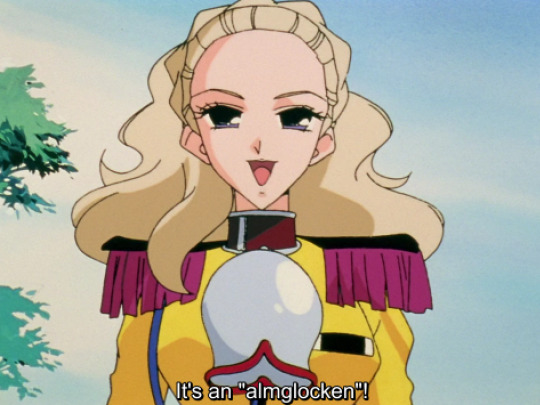
I’ve been dreading this episode since the beginning of this project. Most translations of the cowbell episode have two major problems that I knew were going to be really hard to overcome in my translation.
How on earth does Nanami not know that a COWbell is something that a COW wears?
Why does Nanami keep saying moo in regular conversation?
When I actually got into the translation though, it was so much more difficult than I had even anticipated! Not only were there two very large episode-spanning translation problems to solve, but there were also TONS of difficult individual lines. And on top of it all, a song to translate!
I was not happy at all with my first draft. I sent it to @dontbe-lasanya and went to bed. When I woke up and saw their edit, it was like magic. They had transformed my extremely rough script into a work of art! I’m so so happy with this episode now, and the majority of the credit for that has to go to Anya.
So anyway, how did we fix those two big problems?
How on earth does Nanami not know that a COWbell is something that a COW wears?
Obviously the Japanese word for cow is not “cow”. It’s 牛 (ushi). However, the Japanese word for cowbell is カウベル (kauberu) — it’s a loanword; it’s just “cowbell” turned into katakana. There’s no obvious connection between the words for “cowbell” and “cow” in Japanese, unlike English. Also, カウベル is not a very familiar word for most Japanese kids and teens (the target audience of Utena) and sounds foreign and therefore fancy (given the right context). On the other hand “cowbell” is a very familiar word in English, or even if it isn’t, “cow” and “bell” are. It also doesn’t sound fancy or foreign.
In Japanese, Nanami falls into some cringeworthy teenage social pitfalls in this episode. 1. The classic japanese kid thing of assuming katakana loanwords are cool or fancy. 2. The universal kid thing of pretending to know a word she doesn’t know to seem smart/cool. These things are like, a HUGE part of the conceit of the episode. IMO, it’s crucially important to get these ideas across in the translation. To fail to do so (i.e. by translating カウベル as “cowbell”) would be akin to cutting out the first 8 minutes of the episode.
Translators will often translate katakana loanwords directly back into the original word, but that clearly doesn’t work here. Anya decided to go with almglocken as the translation for カウベル because Miki is the first person to give the cowbell its name, and almglocken doubles as the orchestral term for a musical cowbell (plus the yodelling in the cutaway scenes really sells the German choice, which we only discovered after we had committed to it!). I love how that scene feels where Miki names the bell - it really feels like he and Juri call it an “almglocken” and Nanami just goes along with it, not wanting to admit that she doesn’t know what almglocken means. She totally reads as a stupid kid who wants to be a part of European high fashion without actually knowing anything, which is exactly how she reads in the original Japanese script!
Why does Nanami keep saying moo in regular conversation?
First things first — the sound a cow makes in Japanese is not “moo”. It’s モー (mō/mou) which is prounounced almost exactly like the English word “more” in non-rhotic accents like my Australian accent. In an American accent it probably sounds like “mall” without the ending L sound.
So, cows say “mou”. But もう (mou) is also a dictionary word in Japanese. It can mean “already” as in “I already did that”, but it can also be used as an interjection (similar, but not exactly the same, to how “already” can also be used as an interjection as in “enough already!”). もう (mou) carries other nuances with it as well — there is a cultural image that teenage mean-girl types (like gyaru) tend to use it a lot. I like translating it as “ugh”, which I did several times in this episode.
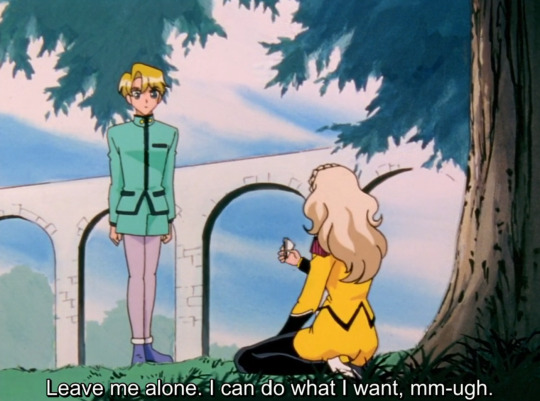
The writers are getting a lot out of the cow metaphor in this episode. There’s the whole thing with Touga selling Nanami away as a metaphor for his manipulation of her (and women in general) in order for him to gain patriarchal power (he even eats her meat!!). But there’s also this equating of cow mooing with the word もう which is associated with young girls. Whenever Nanami moos this episode, even right up until the end when she physically transforms into a cow, you could translate it as “ugh” if you didn’t want to preserve the cow sound meaning. Every moo fits into her sentences as a bitchy interjection.
This is a hard thing to get across in translation, so I used a combined approach. Sometimes I directly translated もう as “ugh”, which morphed into “mm-ugh” and then “muuoo”. Other times I compensated by using words with “ooo” sounds in them and drawing out the sound (like “moOOove”.
Dona, dona, dona, donaaaa
As I mentioned in my post yesterday, while translating the song, I made particular pains to match the meter of the Japanese lyrics with the English lyrics.
あるはれた ひるさがり いちば へつづくみち
One day on a clear lazy afternoon, on the road to the marketplace
A literal translation of the line would be something like this
One clear afternoon, on the road to the market
But I’m sure you can see how this doesn’t have nearly enough syllables, much less stress on the correct syllables. Because Japanese has less consecutive consonants, it tends to have words with more syllables, but shorter syllables than English. They don’t have words like “cramp” where 4 consonant sounds exist in one syllable — usually there’s only 1 consonant per syllable. This means that if we’re matching beat-for-beat, English can fit more words in per bar, which means when translating literally, we end up with lyrics that are too short! That’s why I’ve added “One day on a” and “lazy” and extended “market” to “marketplace”. This came up constantly during the translation of the song, where I was consistently needing to create words that didn’t exist in the original to keep the meter similar.
A few little notes to finish
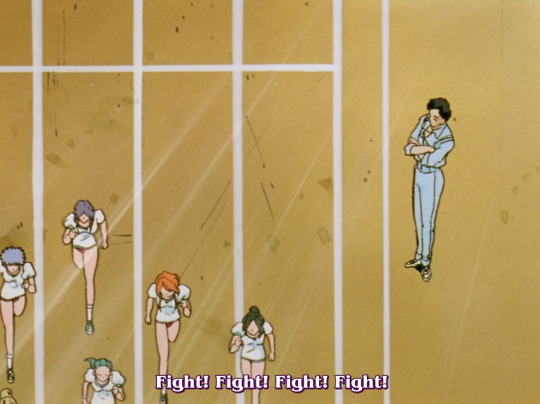
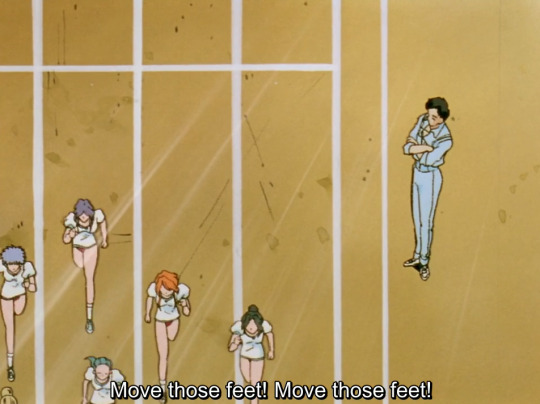
This scene where the girls in PE class are chanting ファイト!(faito) while they run is hilarious to me because both other translations I have access to translated it as “Fight! Fight! Fight! Fight!” which is just… not what they’re saying. Obviously in English chanting “fight!” makes it sound like you’re encouraging two people to physically fight. In Japanese, ファイト is a loanword and does come from the English word “fight”, but it only means “fight” in the sense of like, metaphorically fighting: overcoming mental barriers, pushing through, doing your best. They’re just chanting to get their motivation up. I translated it as “Move those feet! Move those feet!” so that when Nanami brings up the rear I could switch it to “MoOOove those feet!”
Translating it as “Fight! Fight!” is just completely unacceptable no matter what your translation goals are tbh. If you care about “preserving aspects of Japanese culture” in the translation, you should translate it as “Faito! Faito!” or “Fighto! Fighto!”.
I want to note that I’m so happy with how the characters talk about fashion. They really sound like they know what they’re talking about (thanks to Anya). So much of the time translations sound like they were written by someone who doesn’t have any knowledge about the field the characters are talking about, which makes the dialogue sound super forced even when the characters ARE supposed to know what they’re talking about. To give another example, Anya flagged this before with how Touga talks about Miki’s piano playing. The standards are so low for this kind of thing that my limited knowledge of music helped me write a translation that sounded knowledgeable enough to be worth commenting on!
Also, I’m REALLY glad we went with “dyke” as the translation for 男女 (otoko-onna) a few episodes ago. Nanami uses that word again this episode and Utena’s reaction really works with the slur.

Thank you so much again to @dontbe-lasanya. This episode wouldn’t have been possible without you!
Be sure to follow the blog to stay updated with new episode releases! See below for all episodes released so far.
#revolutionary girl utena#rgu#shoujo kakumei utena#sku#utena#translation#utena fansub#japanese translation#learning japanese#japanese#langblr#official blog post
128 notes
·
View notes
Text
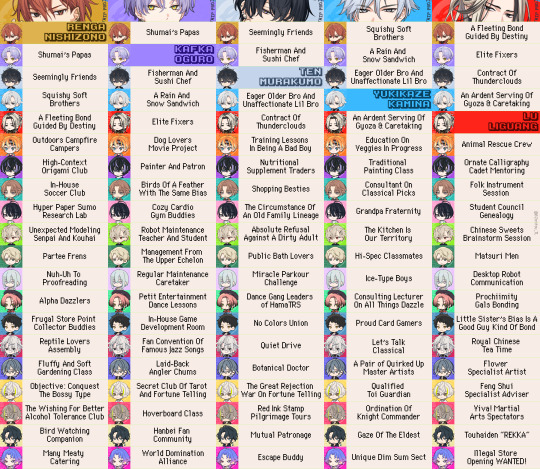
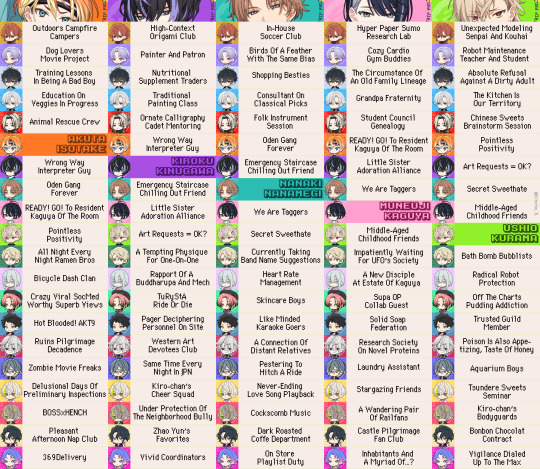
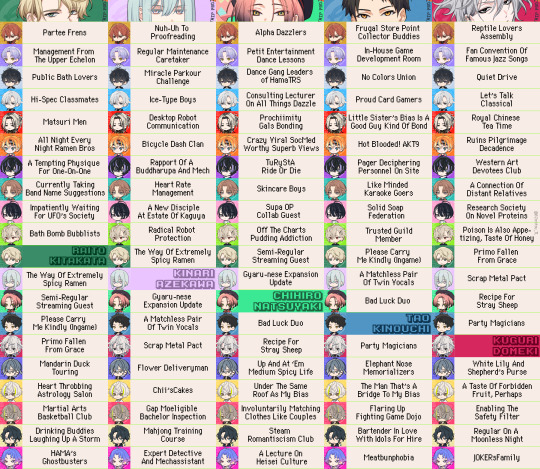

Previously translated pair names that had been posted to Twitter. However corrections had to be made (misinterpretations & an instance of mistranslation), so this is version 2.
Note: This is the only translated thing I will be posting, I am not off hiatus. I had been meaning to archive this before my hiatus, but I also had to fix some things, which is why there was a delay.
Please consult to this post only regarding pair name translations done by me (82mitsu), any other posts or reposts you might see of this chart is the older version. (Previous version has been deleted, but I'm unaware how far the information had spread.)
If any other corrections need to be made, feel free to contact me and I'll make them as soon as possible.
Below follows an extreme lengthy TL note breaking down some pair names, it's a lot of text, so be warned once you unfold the read more.
A lot of research went into these due to 18TRIPs tendency to mix up words, use Gen-Z slang that hasn’t been picked up by everyone yet (or limited to TikTok) and make up their own words (“Omotenashisto” -> “Hospitalister”). I used dictionaries, searched forum results, looked up how people use these words on social media, went TikTok digging, etc.
I tried my best to localize in a way that should make sense even without added context. I only explained the ones that I thought might needed some more back-up in a cultural sense or because it was a specific JPN thing. Thus, not everything has been explained. However, I hope things are clearer compared to the first version that was posted. For Renga & Yukikaze: For ぽゆぽゆ (poyupoyu) there is no definition or anything for this word, but from context clues and digging through how people used it, I deduced that it means something soft and squishy like a plushie or cheeks, so to say. For Renga & Liguang: かりそめの宿縁 (karisome no shukuen) is a Japanese saying about a fated connection of bond that only lasts for a brief moment, but leaves a deep impact on your life. For Renga & Raito: Party is mispelled in the katakana as “paachii” and not the usual “paatii”. Renga has a tendecy to say English words wrong. While “friends” is spelled the correct way, both words have been “mispelled” to drive the point home. For Renga & Kinari: なぁぜなぁぜ (naaze, naaze) is JPN Gen-Z slang from Tiktok. It’s a statement made as an act for complaining, with a bit of sarcasm and irony thrown in at times. Like, “I said I wanna diet but I ate a big meal anyway! なぁぜなぁぜ” or “I’m an idol but I get more anxious doing improv than performances! なぁぜなぁぜ”. Best way I can describe the usage in this context is Renga is throwing a bit of a self-aware tantrum as to why Kinari would correct him. (As mentioned earlier, he isn’t good at English). I guessed a close equivalent would be “nuh-uh”, since that is a dismissal of someone else’s opinion without actual good reason, even if the other person has a point. For Renga & Netaro: まんまん (manman) means “a lot” but I also believe it’s a reference to meatbuns (nikuman). For Kafka & Yodaka: Hanbei is Takenaka Shigeharu, a Japanese samurai from the Sengoku era. He was known for being Toyotomi Hideyoshi’s strategist. For Liguang & Yodaka: 闘牌伝 (touhaiden) is related to Mahjong stuff. 闘牌伝 seems to be an old timey Mahjong video game with RPG elements. Rekka is a fighting game term, and I will quote the website The Fighting Game Glossary by Infil on this: “A type of special move that has multiple stages, as long as you input more commands to continue the sequence. Not all multi-part specials can be called rekkas though; a rekka tends to have exactly three distinct parts and will move your character forward along the ground with each new input.” For Akuta & Nanaki: They went to the same kindergarten and were grouped together in the “Oden Class”. Japanese kindergartens, from my understanding from researching, tend to have a name for their class, rather than a number. To give an idea what such names could be, in 2019 the website hyenasclubs hosted a poll of most commonly used names for classes, and the top 3 were “baby chick” (hiyoko), “peach” (momo) and “dandelion” (tanpopo). For Akuta & Muneuji: My take on はっけよい輝矢部屋 (hakkeyoi kaguya heya) is a bit of an elaborate bit joking with Princess Kaguya of the Moon (from Tale of the Bamboo Cutter) because I was wondering why they suddenly opted for Muneuji’s last name instead of first. (I might’ve also just overestimated Kaguya Heya being some joke on Kaguya Hime). Hakkeyoi is what a referee shouts at the start of a sumo wrestling match. For Akuta & Ushio: I think ポジティブに腕押し (positive ni ude oshi) is a take on 暖簾に腕押し (noren ni ude oshi) that means something has no effect or is pointless. Lit. it means “pushing a curtain with one's arm”. For Akuta & Tao: Akuta Nine is a joke on the baseball movie Gyakkyo Nine which is an adaptation of the manga of the same series, I believe. The movie is referred to as GK9, hence I made it AKT9. For Akuta & Ryui: The original is OYAxKOBU which comes from 親分子分 (oyabunkobun) meaning “boss and his underlings”. Akuta also calls Ryui by “Oyabun”.
For Kiroku & Nanaki: Weebs who watch highschool anime should be familiar with this, but emergency staircase refers to the hallway stairs in a JPN highschool that are sometimes used as chilling out spots by students. For Kiroku & Chihiro: TuRyStA is the clothing brand they wear. 18TRIP has a various selection of clothing brands, which each character having a preference for one or another. For Kiroku & Yodaka: Zhao Yun, as quoted by Wikipedia, “was a military general who lived during the late Eastern Han dynasty and early Three Kingdoms period of China.” For Ushio & Raito: Some heavy freedom was taken with バスボムしゅわリスト (basubamu shuwaristo). After considering how to approach it in the most sensical way, I decided to translate it as “bubblist” due the other options being “hand sign list” or “bubble list”. I thought リスト might function as in -ist, like dentist, artist, guitarist. しゅわ comes from しゅわしゅわ which means bubbly. Although bubblist isn’t not that common, it is sometimes referred to entertainers that do bubble performances (in English). And I think it made more sense than “hand sign list” or “bubble list” to say the least. This was also taking in consideration how 18TRIP, as explained in the intro, gets very creative with its language usage. For Raito & Nagi: Mandarin ducks symbolize “soulmates” of some kind in China. In other words, Mandarin Duck Touring is more along the lines of “Motorcycle touring soulmates”. However, I find the mandarin duck reference and interesting pull compared to just “soulmates”, so it was kept as is. For Kinari & Ryui: “Super Darling Gap Inspection” is more along the original lines. “Gap” in Japanese is usually used in the context of when someone acts one way, but unexpectedly, can act a different way. Ex. A very shy person shows they can be super vulgar, that can be considered a “gap” of some kind. In English, people are more familiar with “gap moe”, thus gap moe was used. For Tao & Nagi: Might be a reference to Yokohama’s Zo-no-hana (Elephant Nose) Park. For Toi & Yodaka: The original is more along the lines of, in the most literal sense, “going around raisins circle (of friends).” Toi likes raisins, but Yodaka doesn’t, so Yodaka passes them onto Toi. I’ve turned into on a play on “sharing is caring” since that’s a common concept in English.
284 notes
·
View notes
Note
I don't know but couldn't that maybe the reason twst gave Leona the feminine version of the name instead of the masculine version is because of the Japanese pronunciation is easier for Leona? (I have no clue about japanese pronunciation but sometimes I feel they find some names in English hard to pronunce in Japanese)

[Referencing this post and this post!]
I don’t think it’s a matter of difficulty in pronunciation; Twisted Wonderland has far more complex names (like Leona’s surname) and words for the VAs to say. Merely slapping on an extra sound (-a) at the end of a name doesn’t drastically make the difficulty spike in most cases, Japanese or not. (If anything, the r/l sound starting off his name is the most complex of the sounds in his name; vowels by comparison are easy.)
This also doesn’t explain why other characters have names usually perceived as feminine in the west (Lilia, Jade, etc.)—though I’d like to point out that the -a at the end of names usually indicates femininity in romance languages like Italian. It doesn’t carry the same connotation in Japanese, so maybe the -a at the end wasn’t intentionally meant to convey femininity.
I guess it’s just a design choice the team went with?? There doesn’t need to be a deep reason for it.

We don’t necessarily equate irl logic to fictional characters though! So even if men have longer lashes than women in the real world, our brain doesn’t overlay that over this silly cartoon or anime character.
A lot of this also has to do with socialization and what you’re exposed to growing up. A TON of media—especially in the west—has certain visual indicators for femme characters. For example, the color pink, bows, makeup, curvier bodies, boobs, long hair, fancier designs, etc. See the images below:





We’re more likely to base our understanding of fictional characters’ gender identities based on other media we have consumed. This is especially true the more unrealistic the fictional character is. Like, I doubt many are seeing an anthro rabbit and comparing her lashes to those of their actual guys they know irl.
With Japanese culture now blowing up in recent years, a lot more “normies” are getting into it. And what is the kind of media normies are used to seeing and basing their judgement on prior to getting into anime?? That’s right, the very same cartoons and such that instilled those “femme indicators” in them. Even within preexisting anime fans, we tend to assume long lashes + makeup indicates a female character, an effeminate or pretty boy, or even queer-coded.
#twisted wonderland#twst#disney twisted wonderland#disney twst#Lilia Vanrouge#Jade Leech#Leona Kingscholar#notes from the writing raven#question
58 notes
·
View notes
Text
Graffiti on Fuurin High School ground
This is a continuation of Part 1 (it was too long I feel like I should halve it). You don't have to read it in order to understand this post, but you are more than welcome to!
Let's continue!

Tiger and Dragon (Sakura and Sugishita)

The drawing of a tiger and a dragon on class 1-1's black board refers to the idiom (龙争虎斗) from eastern culture, meaning the clash between dragon and tiger, which are two of the most powerful creatures. The idiom is used when two opponents who (often) hold grudges and are equally powerful face each other. Tone wise, it is a positive phrase, leaning towards amazement and admiration from an outsider's point of view.
I'd say Sakura is the tiger and Sugishita is the dragon here based on their physiques (Sakura is small but flexible and resilient, while Sugishita has long limbs and tends to strike his opponent heads-on with force).
Graffiti on the wall in chapter 3 as a foreshadow for Shishitouren Arc

As the section name suggested, this is definitely a reference/foreshadow for Shishitouren Arc. On the wall, we can see a rabbit chasing down a man with a (rather dangerous, oopsie) baseball bat while other animals (foxes to the left and I'd say bears to the right?) look on and laugh.
This is the expected scene in the run-down theatre Ori. The rabbit is their leader - Tomiyama Chouji, as his name has the word rabbit (兎) in it. Moreover, having animals in them is the common Shishitouren name theme (I might make a separate post on this haha surely). E.g. Togame Jo is a turtle (亀), Sako Kouta is a fox (狐), Teruomi Inugami is a dog/wolf (犬) (note: I can't access the original Japanese publication since it's paid only so I'm only guessing based on the "inu" in his name. For anyone interested, he appears in chapter 127).
Skulls/Skeletons


Skeletons and skulls are easily seen throughout Fuurin. Most of the time I believe it's just because it's a common thing to graffiti. It's also interesting to think about how they represent violence and death, while Boufuurin are just little babies running around protecting the town haha.
Little blobs accompanying the skeletons <3


It is clear that the large skeletons are looming over the little blobs, but the skeletons don't look hostile and the blobs aren't scared of them. This makes me think that the skeletons are Boufuurin students and the blobs are the people of Makochi who are under Boufuurin's protection.
Overall I just think they're adorable. They are literally you and me :3 :3 :3
#writing this makes me wanna write more analysis posts tbh#writing wbk post has become my coping mechanism /pos#i have so many ideas queuing up in my google docs yall have no idea#sakura haruka#suou hayato#suo hayato#nirei akihiko#sugishita kyoutarou#sugishita kyotaro#fuurin#boufuurin#wind breaker#wind breaker nii satoru#wbk#wind breaker nirei#wbk analysis
107 notes
·
View notes
Text
Rise Characterizations Pt. 5!!!!!
Okay I promised I'd share my Splinter reference notes, so here I am! Also wanna take a moment to thank everyone reblogging the prev. parts. All the tags/notes are so sweet!!! Anyway, here's our one and only Rat Man,
Splinter Character Notes

Language Habits:
Catchphrase: "HOOOOOT SOUP!!!"
Will yell "whoa/oh nelly!" when in a tight spot or stumbling around
Makes puns/dad jokes, and laughs at said jokes to himself
A poor liar, will skirt around the truth until you drop it
Penchant for interrupting people if he's not interested, devout user of "yada, yada", "ah, bup, bup, bup"
Verbalizes his attacks/moves, something his sons pick up on. Could be a habit picked up from his action star days, such moves include: lights off jitsu, and slow motion jitsu
Uses 2010's slang, (i.e. "totes", "chillaxed"), could see him incorrectly using up to date slang to embarrass his boys
In a group refers to his sons as "boys"
One by one will refer to his sons by their designated colors, but will pull out the full name (not nickname) if the situation is serious
Also refers to Donnie as "the funny one"
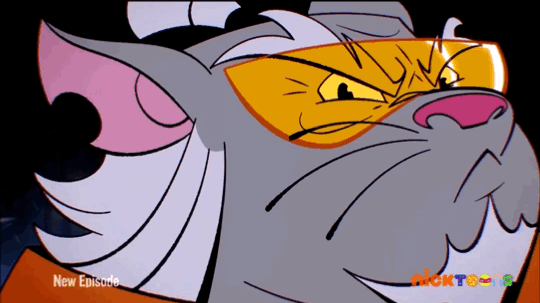
Personality:
A performer, well he is an actor after all. He knows how to captivate an audience. Splinter likes attention--something that may be connected to his strict childhood with high expectations--but he also performs for his boys. To keep them happy, but most importantly safe. This also means he keeps his true emotions tucked closely to his chest
Jovial. Despite his dark past and heavy responsibility thrust upon him at a young age, Splinter is always laughing. He finds the fun in everything
Secretive. As mentioned before, Splinter tends to keep things close to his chest. Despite this, he's a terrible liar. He'll just avoid the truth until it comes back to bite him in the ass. This makes him sometimes a little emotionally unavailable
Lazy. He always finds the easiest way to do something, and procrastinate on his responsibilities as long as possible
Vain. He's glory seeking for all the proper attention he lost in his youth. So the Lou Jitsu aspect of his life boosted his ego in irreparable ways. He also uses the identity of Lou Jitsu to escape from the idea of being stuck as a rat. Glorifying the past is way to find comfort for him
Adrenaline junkie. Part of that glory-seeking and glorification of the past manifests into him needing adrenaline to feel alive. (i.e. when he steals the tank)
Attentive and empathetic. He can be a little hare-brained when it comes to remembering the details, but he's always very attentive to his sons needs. In flashbacks he's shown to supply them with items needed for their interests (i.e. little Mikey gets art supplies), and always apologizes when he messes up (i.e. the conversation he had with Donnie). This empathy also extends to other people and animals, as he was sympathetic with Cassandra when she was lamenting about the foot clan and was immediately worried about the turtles Draxum had in his lab
Protective. He would sacrifice everything to save his sons, and he does
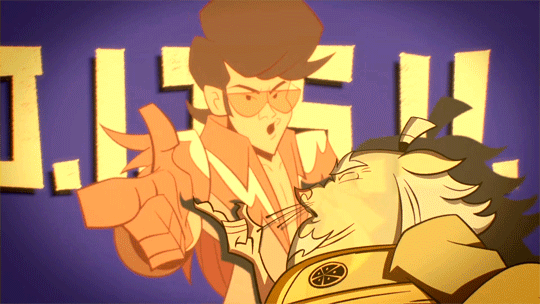
Miscellaneous:
His tail is Very expressive, and one of the most active parts of his body, so if you want to subtley show emotion I'd focus on that
Has a Lou Jitsu body pillow
Remembers all his stunt double's names
Snores loudly
Talented singer, can sing opera and lived next to a karaoke bar in Japan
The show he watches the most is called "Soapy Treadmill", a Japanese game show where they throw things like scorpions at people who are soapy on treadmills
Has a "do not touch!" cabinet, full of trophies, mystic artifacts, and mementos of his past
I have a List of all the mentioned Lou Jitsu movie names mentioned in S1, but I'm probably gonna wait till the end of my S2 rewatch and post it separately (it's also long too). Will link here!
I'm also gonna add a recommendation here at the end.
This is for the white and non East Asian folks. I'm not as well-versed in East Asian or Japanese culture, but Splinter is a first generation immigrant! He keeps a distance from his heritage because of the trauma of his youth, and the role Lou Jitsu probably also forced him to westernize his identity to make it more palpable to Hollywood. But it would be a disservice to sever parts of his identity, because one is uncomfortable or not knowledgeable in writing it.
For my white folks intimidated by writing a person of color because they want to get it right, research always helps. Research helps with everything!!! writingwithcolor here on tumblr actually has a lot of useful resources, here's their guideline, and a research chart one of their moderators created, which I personally found to be very helpful. I believe their ask box is closed right now, but if you ask questions in the future be nice!!!!
Anyway I'm gonna do April next :)
#rottmnt#rise of the tmnt#rise of the teenage mutant turtles#tmnt#teenage mutant ninja turtles#rottmnt splinter#rottmnt hamato yoshi#character analysis#writing#fanfic#long post#critter talks#rottmnt lou jitsu
455 notes
·
View notes
Text
Ik im like head in charge of bitching and moaning when it comes to Hiro mashima but one thing I will always appreciate is how he names his characters. A lot of anime, even stuff that's set in fantastical locations, tends to stick to Japanese names which makes sense but I fr love the diversity of culture in the fairy tail characters names it really does help to make Fiore feel like a different world but still adjacent to our earth. I never realized how much that would add until I watch other shows and realize that even though they aren't supposed to be set in Japan I still am kinda surprised that it isn't because all of the characters have Japanese names.
In fairy tail the location is a kind of earth adjacent alternate reality where people have magic. It really feels like a modern day fairy tale, the speaking, clothing, and style feel more modern while the technology is all much farther behind because in this universe magic is used instead. It's a fantastical world but still one rooted in reality. the names all being so diverse in origin but still many being names somone could reasonably have in the real world rather than just made up words makes that idea stick so much more then you might think at first.
#fun fact when i was a kid and heard juvia and arias names i thought all the element four where supoosed tobhave spanish names#so i was so confused about sol because in spanish sol is sun#its cuz hes french😭#in french sol is earth😭😭😭😭#fairy tail#natsu dragneel#lucy heartfilia#gray fullbuster#erza scarlet
67 notes
·
View notes
Text
Haikyuu Characters' Informal & Formal Speech
Something I find interesting about different languages and cultures regarding sociolinguistics is the entire idea of formality. Of course, there are ways to sound more formal/polite in English and ways to sound more informal/rude depending on word choice (synonyms). But with a language such as Japanese, it's the grammatical structure itself (verb endings, vocab) that changes to convey varying levels of formality.
An example would be:
大丈夫? (informal) vs 大丈夫ですか?(formal) = Are you ok?
daijoubu vs daijoubudesuka
これは本だ (informal) vs これは本です (formal) = This is a book.
korewahonda vs korewahondesu
In a school setting, the younger grades (kohai) will use formal speech with the older grades (senpai) as well as teachers: meaning 1st years will be formal to 2nd and 3rd years, 2nd years will be informal to 1st years but formal to 3rd years, and 3rd years can be informal to both 1st and 2nd years.
This is easily shown in basically any anime but this post will focus on Haikyuu since it's the one I'm most familiar with.
Karasuno: Kageyama and Tsukishima definitely hold a very high level of politeness towards their senpai as they always speak formally towards them and also always call them "full surname-san" (Azumane-san instead of Asahi-san, Sugawara-san instead of Suga-san, Sawamura-san instead of Daichi-san, Nishinoya-san instead of Noya-san). It makes sense for them since in general their personalities are quite strict and rigid. Hinata also speaks formally to his senpai but calls them by their more usual names (Daichi-san, Suga-san, etc) and he tends to forget to speak formally out of sheer excitement (not because he's trying to be rude) so he ends up adding on the formal desu copula to quickly change his informal sentence to be formal at the last second. You might think that Tanaka and Nishinoya are pretty relaxed when it comes to formalities due to their crasser personalities but I would actually say it's more the opposite. They're both characters that really like upholding the entire senpai-kohai relationship and it shows in that they are always respectful to the 3rd years and use formal speech (it's also shown in how they both loveee being called senpai and specifically Nishinoya's relationship with Asahi). They still call the 3rd years by their more common names so they aren't as rigid as Tsukki and Kageyama when it comes to names though. The scenes in season 1 when Noya and Asahi were fighting (specifically the storage room fight) were surprising in particular due to Noya changing to informal speech while arguing with Asahi (his senpai).
some other random formalities I've noticed in the other characters: as mentioned in the anime, Kenma doesn't like any of that hierarchy stuff which is why Hinata is able to continue comfortably speaking informally to him even though Kenma is a senpai. The shock and immediate apology of Hinata when he finds out Kenma is older than him is sensible in the cultural context since there are many people who would get quite offended and angry if a kohai were to be speaking informally towards them. Although Kenma is never shown directly talking to any 3rd years (other than Kuroo, which he speaks informally to since they're childhood friends), I assume he would still speak formally since even though he doesn't find formal speech necessary he would still be aware that others would care about it. When it comes to Mad Dog, a small part of me expected him to be completely informal to everyone since those kind of characters are usually like that in anime but he still keeps a pretty formal tone when talking to his senpais which pleasantly surprised me. As far as I remember watching season 4, I don't think the Miya twins use formal speech when talking to Aran. They don't call him Aran-san or anything either, just Aran-kun, which could be another example of childhood friends not needing formalities even with the age gap.
EDIT: i just remembered that Kageyama is so damn polite that he doesn't even differentiate between the Miya twins by their first names, he calls them both "Miya-san"!
If anybody wants a particular character/school to be discussed in detail then just send me an ask and I'll try!
side note: this post isn't proofread so if theres any mistakes or corrections in the info please tell me (✿◠‿◠)
#haikyuu#karasuno#tsukishima kei#kageyama tobio#hinata shoyo#kozume kenma#kenma#kuroo tetsurou#miya twins#miya osamu#miya atsumu#nishinoya yuu#noya#sawamura daichi#sugawara koushi#asahi azumane#tanaka ryuunosuke#japanese linguistics#japaneselanguage#anime#anime and manga
143 notes
·
View notes
Text
Welcome to: Me attempting to explain Caleb and where he sits relationship-wise with MC- (Because I saw discourse surrounding the brother stuff and I investigated IT BECAUSE WHY NOT)
FIRSTLY, This is Caleb:

The main issue surrounding the military (airforce technically) man is that he is referred to as brother in the Chinese, Japanese, and Korean versions of the game (as far as I know), while in the English (Western) version of the game, he calls himself MC's childhood friend despite the two being adopted by Josephine (aka Grandma). Neither of the parties mentioned are related by blood. (I am not implying blood family is stronger than adoptive but I digress).
With the issue of the brother term being used in the Chinese, Japanese, and Korean versions of the game is not because MC sees him as a sibling. In many cultures in Asia (from what I've researched), tend to call each other names that may not actually mean the person is that specific figure, if that makes sense. For example, some may call either blood-related or not aunts and uncles parental names, but these figures are not the person's parents. While in the English version, he is referred to as a friend due to the west mainly not having this sort of term idea used since we tend to be more literal in the English language (sometimes). This part seemed to stem from Infold trying to properly localize the game and its story which led to confusion surrounding what many (like myself), should see Caleb as due to a lack of nuance and the terms being different in game.
It seems what Infold was intending was to say that MC and Caleb did grow up together and were adopted by Josephine, but the two were not put into a familial situation in their living situation. It was more likely the two grew up as friends who happened to live together possibly due to how Josephine may have raised the two characters. But who knows.
It overall seems that Caleb and MC were never intended to be looked at as siblings but translation issues and cultural difference paired with a lack of explanation story-wise, left a divide on what Caleb was to MC. Which did leave many (like myself) confused as to his stance with MC. Though we shall see as the game continues with Caleb's story on the 22nd.
To end things off, this is just my take on it after doing my own research into the given issue. I do not intend for this post to be used to ridicule or hate on those in the fandom who may have different takes. This post is only here for explanation purposes for those who want it.
_____________
TLDR: Caleb and MC aren't adopted siblings but childhood friends who grew up together, but issues arose from translation differences and story issues.
#love and deepspace#love and deepspace caleb#caleb love and deepspace#cw: slight drama#long post#just my thoughts
21 notes
·
View notes
Text
Stop Trying To Defeat Racism With Logic
There's a black samurai in the new Assassin's Creed game, and it has made some people mad. You simply don't have to argue about it.
The new Assassin’s Creed game is set in feudal Japan, which is cool. It stars what appears to be a female ninja and a black samurai based on the historical figure Yasuke, which is also cool. Anyone who tries to argue about whether or not that’s cool is just not worth your time. In case you haven’t been paying attention for the last ten or twenty years, video game culture tends to be a repository for the most tedious people on Earth. You know the type—these are the kinds of people who don’t consider mobile games to be “real games,” or who harass women who use their mics in online multiplayer games, or who argue about “historical accuracy” in a video game that has dragons or elves in it. These kinds of people show up in a lot of nerdy hobbies, like tabletop gaming or whatever it is people do on Letterboxd or even enjoying Greek and Roman history. From the moment that the key art for Assassin’s Creed Shadows depicted a black man in samurai garb, I knew that this particular brand of person was going to get ripshit mad. Just look at the replies to this tweet. It’s absolute nonsense in there. The most amusing replies are the ones that take into question the, of course, historical accuracy of this character. It may be tempting to try to argue with these people, for a lot of reasons, most of all that history and facts are on your side. This character appears to be based on Yasuke, a real guy who actually existed in the historical record. He was an African retainer for warlord Oda Nobunaga, meaning that he was indeed a samurai. Yasuke is a well known enough figure that he’s the subject of a Netflix anime that is named after him. He’s also a character in Nioh, which was developed by the Japanese studio Team Ninja. You can repeat those facts until you’re blue in the face to people who are determined to be angry about a black man having a leading role in this game, but it won’t matter. You should just save your breath and look forward to seeing whether or not Ubisoft fumbles this very easy layup. Racism isn’t a logical position, so you cannot defeat it with logic. Facts just don’t matter to a racist, especially not the tedious kind of racist who makes their home in video game culture. There will always be a new hair to split, a new way for this kind of person to object to a black man being in this video game. You can bring up the other fantabulous aspects of the Assassin’s Creed franchise that clash with history: the existence of the titular Creed and the Knights Templar; whatever the fuck was going on with the Apples of Eden; the series’ depiction of Karl Marx as a devotee of democracy rather than advocating for an armed revolution of the proletariat. It does not matter because the people who are mad about this have already made up their mind. To them, Japan is a place that does not and has never had black people live there or make their homes there at any point in time—especially in history. The anger about “historical accuracy” is just a slightly more reasonable smokescreen for their real objection: having to see a black person at all. Unfortunately, blackness and black people have always been inescapable, both now and in the past. I’m not going anywhere, and I won’t be dragged into an argument about the value of my very existence.
87 notes
·
View notes
Text
New gesture Emoji in Unicode 15.1: Head Shaking Horizontally and Head Shaking Vertically (aka shake and nod!), and (finally) right facing emoji
Unicode 15.1 will be rolling out to phones and computers across this year. It will include lots of new CJK (Chinese Japanese Korean) ideographs, some new line-breaking rules for syllabic scripts, and a handfull of new emoji! There's a phoenix, a breaking chain, a lime and a brown mushroom, as well as new family silhouettes and a handful of existing emoji, but now facing rightward!
Below are illustrations of the set from a recent Emojipedia summary of the 15.1 update.
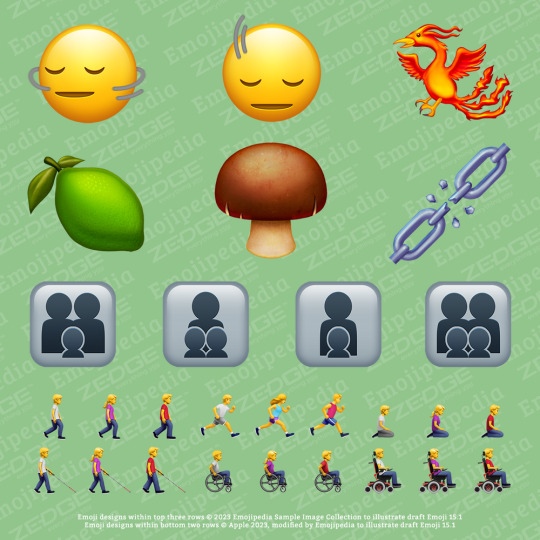
The two emoji I'm most excited about are Head Shaking Horizontally and Head Shaking Vertically. That's head shaking and head nodding to you! I wrote these proposals with Jennifer Daniel and the Unicode emoji subcomittee team.
Why the more elaborate names? Well, Unicode tend to describe emoji by form, not function. That's for very good reason, because a head nod might be agreement for you, but in other cultures a vertical movement of the head can mean disagreement. This has provided a double challenge for emoji designers, who have to both show movement and also facial features that aren't too positive or negative. Below are the Emojipedia pair. They've done a great job.

These two emoji are actually made by combining a classic emoji face wtih the horizontal (🙂↔️) or vertical arrows (🙂↕️ ) using a special Unicode character called a Zero Width Joiner (ZWJ, 'zwidge' to it's friends), which means that even though they're two characters they smoosh together to create one emoji. It's the same process that makes all the different flags, as well as the gender and skin tones.
In fact, all of the emoji in 15.1 are combinations using the ZWJ mechanism; including the phoenix (🐦🔥), lime (🍋🟩) and brown mushroom (🍄🟫 ). Those new right-facing emoji are a combination of the usual left-facing emoji and a rightward arrow🚶➡️ .
It's exciting that Unicode have decided to try this set of right-facing characters. Many emoji are left-facing, which is a legacy of their Japanese origins (the word order in Japan means that right-facing makes sense). I've been complaining about emoji directionality since 2015, and I'm glad that this update will mean that lil emoji dude can finally escape a burning building for those of us with a left-to-right writing system and Subject Verb Object word order. They've started with a bunch of people in motion. It will be interesting to see if this set is where it stops or not.


(no no buddy!! To the exit!!)
The use of the ZWJ is an elegant solution because it means that you don't have to make a whole new codepoint for the emoji, it just uses the old one. If someone doesn't have their phone or computer update to 15.1 then it should fall back to just showing 🚶➡️, which somewhat conveys the intent. That's the magic of a good ZWJ combination.
Earlier posts on emoji gesture
Gesture emoji: contributing to the Unicode standard
New Publication: The Past and Future of Hand Emoji
Gender Variations for Person in Suit Levitating Emoji - Emoji Proposal
New draft emoji include 3 proposals I co-wrote!
Emoji as Digital Gestures in Language@Internet [Open Access]
Earlier posts on emoji directionality
Emoji Deixis: When emoji don’t face the way you want them to
Don’t run towards the fire (the on-going problem with emoji directions)
79 notes
·
View notes
Text
What we know about the girlies!
All the canonical information we know from their introductions, comics, and music videos!
Vampire

16 years old (only member with confirmed age)
Seems to be an actual vampire judging by her manga
Her favorite food/drink is tomato juice, she's also implied to use it as a substitute for actual blood
Used to be a lot less confident in herself, uses cute stuff and life as an idol to make herself better!
Slow to get going, tends to be more active at night
Gamer.
Animal

Shortest member
Has the ability to fall asleep anytime, anywhere
Often asks the other members for bites of their food, also eats most of the leftovers
Collects cat-related trinkets, and wears them as a part of her outfit on stage
Fights with Vampire a ton
Status

Tallest member
Attended Otoiro High School at some point (depending on age)
Cries over fairly arbitrary things
Likes to thrift and works at a second-hand store in her free time
U

Originally from America, specifically the west coast
Left America to become an idol in Japan (from the note from her partner in the Mannequin music video)
Interested in Japanese street culture and also breakdancing apparently
This is absent in translations of the anthology, but she always ends her sentences in katakana to insinuate an accent or non-native pronunciation; (eg. やっぱりUFOとかもいるのカナ?)
Her favorite food is shirako ponzu
Cinderella

Her real name is Satsuki(?)
Wears glasses doesn't really need them since she has 15/15 vision
Admires Vampire to the point of potential romantic interest
Reads a lot of shoujo manga
Was a part of her school's production of Cinderella as a stagehand
Auditioned for Mannequin
AngelHair

Fans call her Kesa (hence why i call her that!!)
Small animals follow her around (and Animal)
She likes to make perfumes in her spare time
Member of her school's environmental committee, where she is one of two members
High spice tolerance, likes to slather takoyaki in wasabi and her favorite food is spicy tanmen
Terrible cook (somehow manages to explode an oven)
Often shown to be (potentially) stimming (fidgeting with her hair or has her hands clasped together/touching her face)
Gift

Looooveeess to watch movies
Good at reading the room and notices even the smallest changes in the other member's behavior
Deco*27's favorite
Parasite

Likes to just stand in dark rooms, the other members get mad at her because she turns off all the lights in the dressing room
Hates being alone
Associated with anemones, which symbolize forsaken love, sickness and withered hopes
Besties (..?) with Animal, she feeds her oranges
Canonically shows romantic interest in women

Dilemma

Has "more life experience" than anyone else in the group, so is most likely the oldest
Won a world ranked FPS competition at some point
Strict, but tries to support the other members as best she can
Potentially the only "real" member, the rest are just made up as a coping mechanism
Trauma dumps so much it's not even funny
#the album ended 2 years ago and roe's still here!!!#it's 3 am here and i cant sleep and i like them so you get this post#the mannequin tag#deco*27#screaming into the void
25 notes
·
View notes
Text
Fire Emblem and Aesthetics-A Mini Discussion
So for those who don't know, I don't really play Fire Emblem Heroes, but I still have an interest in seeing what units they release. Usually for fanfic purposes or just keeping track of new resplendent designs. But recently, FEH had an update for the original character of Dagr and it got me thinking about how resplendent from jotunheim look

Combined with FEH's ongoing storyline of taking from Norse mythology it really made me think-"Wait, why don't we have a Norse Fire Emblem game?"
Now look, I'm not here to bemoan that FEH don't have a console version, non gacha style game, but it really got me thinking about how we may be missing out on something relating to the use of a rich mythology and it only being in a mobile game more about collecting waifus and husbandos.
You see, Fire Emblem is no stranger to cribbing from existing mythologies like Norse in Genealogy, Arthurian myth and the matters of France in Elibe, and several characters just straight up being named after mythological/classic literature characters like Beowulf, Sampson, Priam etc. But its always done in this relatively Anglo-Saxon-British-French homogeny of aesthetics for their tales. So we can have a character named Sigurd, but he's not gonna look like he's fresh off the Viking Ship. Now Fire Emblem isn't the only franchise to do this, many pieces of media made by other countries draw upon these sort of exaggerated/romanticized look for fantasy stories all the time. And I want to be clear I am not advocating for "Medieval accuracy," I think that's silly. What I'm more getting at is I feel like FE could do with changing up its setting/aesthetics to perhaps inspire newer experiences.
Now I'm not saying FE as a franchise needs to be reinvented. In fact, I think FE has one of the most universal accessible mechanics in turn-based gaming. Simple to pick up, but still able to create many difficult maps and challenges. And by this point has made the support system one of the most iconic in gaming. But if the mechanics are good, doesn't that mean it could be transplanted into another setting? Well, In a way, yes. But once again, I'm not advocating for FE to stop being this fantasy style sword and sorcery story and become like the Napoleonic wars.
(That is a real Nintendo game by the way. Its wild!)

No what I'm saying is that the broad terms of "Middle Ages Warfare" is much more than simply a certain type Eurocentric fantasy.
I'll tell you what, as much as people like to rip on Birthright, I'm still shocked how it took so long for Fire Emblem to have a game where Japanese culture and aesthetics is super prominent and a main setting for a game. Fire Emblem tends to have one character who is obviously inspired by Japanese culture or even sometimes a single country. But a full blown game where so many characters come from and embrace this Japanese backdrop was unique.

Now of course it was still Birthright, so while you got these cool glimpses of a unique world and story like the Oni inspired Flame Tribe, the start of having a lot of retainers as main characters, the monk class and using fans as a weapons, and even roping in Kitsune. It still doesn't really do much than an average FE adventure with them. But it did at lease prove the the FE formula *could* still work removed from its conventional trappings.
Another in the different aesthetic, but missed opportunity category would be Fire Emblem Three Houses country of Almyra being pretty heavily inspired by Persian/Middle Eastern culture. A country that was gesturing so hard at an interesting idea that its left fan artist and fanfic writers to swoon over the idea of a possible FE game set in Almyra.


And if you want an even more recent example, for all the desert backdrops we've had in Fire Emblem, its kinda astounding it wasn't until Engage that we got a lightly (And admittedly exaggerated) African inspired country.

When I see stuff like this and what FEH is doing it makes me realize that we could be getting more. Im sure the next FE will likely still lean on its typical fantastical Anglo-Saxon look, but eventually there's got to be some spice to it. Sure it may be different, but Fire Emblem is a franchise that with each entry does try to be something different while maintaining certain core gameplay elements. So what is the harm of trying to approach something that looks a bit different?
Im not asking for an extreme change right away. Maybe start lighter. We have tons of pirates in Fire Emblem, why not a pirate/sea based game? We've even had the rare few pirate as a playable character. Its a type of story that could be told within the typical Fire Emblem world.

Then perhaps maybe something a bit more culturally ubiquitous like Greeco-Roman inspired FE? There's plenty of gods and magic, but also swords and spears to draw forth on. Heck, that may even open up new potential enemies or stories to tell with like an Evil Senate or a Gladiator culture. It could even push FE to maybe drop or reinvent certain tropes like how they approach the knighthood type of character where a certain culture's version of knight is different. Maybe even make new classes the way Birthright had to.
Overall, I think Fire Emblem is and always has been a malleable franchise. And because of that, I think it can afford to take certain risks on something as simple as drawing from another culture during the medieval magic era, while still being able to provide things that people still love about the franchise like the combat system and support system. Will there be push back on it looking different? Of course, I remember when Three Houses first teasers dropped and everyone was wondering what was up with the military school outfits and what even race was Claude. And of course a different aesthetic doesn't make the game automatically good. But let's remember, that people were judgmental of Birthright not because it went all in on looking Japanese, but because the general story and writing was lackluster for many.
But if you can make an interesting and likable cast of a characters that elevate the story, and make a memorable world for people to wage war in, I see no reason why you couldn't make Fire Emblem work set in the Netherlands.

If there is a personal aesthetic or theme you'd like to see Fire Emblem tackle, sound off in the replies. I'd love to hear what you guys think.
#fire emblem#fire emblem heroes#feh#dagr#nephenee#almyra#solm#norse mythology#fire emblem three houses#fire emblem birthright#fire emblem fates#fe fates#fe3h#claude von riegan#ryoma fire emblem#takumi fe#takumi fire emblem#fe corrin#corrin fire emblem#corrin#sakura fire emblem#hinoka fire emblem#fe14#timerra#timerra fire emblem#veronica fire emblem#discussion
20 notes
·
View notes
Text
Fishing Yuri vs Reproductive Fascism
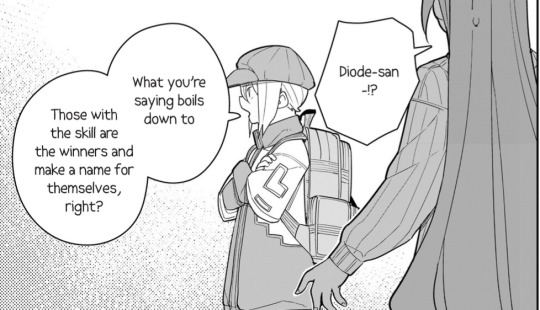
Issui Ogawa's Twinstar Cyclone Runaway novel series caught my attention the moment I learned about it. A gay marriage allegory in a weird sci-fi setting? Sign me right the fuck up. I've always found explicitly political sci-fi interesting, and well, Ogawa is not exactly a small name in Japanese sci-fi. However, a Japanese hard sci-fi novel is not going to have an easy time finding a good translation to English, much less a fanbase. So I was really excited to see that it was getting a manga adaptation, and from what it has adapted so far (~half of the first of three novels in an ongoing series), it's really living up to my feeling of hype.
There is a general setting summary after the break, and then a section where I talk a bit about the most recent chapter (8), and how it really makes a cogent argument extractive economic systems are reinforced by patriarchal norms.
The plot centers around Terra Intercontinental Endeavor, a woman who has inherited her family's fishing boat. The fishing boat requires two people to operate, a job which is performed by straight couples as a form of marriage contract. The use of married couples is understandable, given that the fishing boat transformable rocket plane that descends from orbit to operate in the skies of a gas giant, an operating environment which requires almost preternatural communication skills between the pilot and the person transforming the ship. The fish that swim around in the gas giant's skies are special: they're made of a kind of clay that can be molded by thought. The catch forms the backbone of the planetary economy; otherwise, the planetary system is so resource-starved that humanity cannot sustain itself without something to offer through galactic trade networks. Terra is highly gifted at producing complex transformations of the ship, but cannot communicate well with the male pilots she is interviewing for marriage. Part of this is because her way of describing things is a little kooky, but the majority is because the patriarchal culture she lives in has produced a lot of condescending, sexist guys who Obviously Know Better.
Fresh off a round of failed marriage interviews, Terra is desperate to find anyone who can pilot the boat. In steps a mysterious girl named Diode, who proves herself to be an exceptionally talented pilot whose skills mesh well with Terra's. So far, the story has alternated between Terra's experiences within the stifling cultural life of her home, and the moments of dizzying freedom and connection that Terra and Diode find when they're out fishing.
(Spoilers from here on out, so stop here if you would prefer to read more on your own. )
As far as the broader world of Twinstar Cyclone Runaway is concerned, the first seven manga chapters have largely focused on how badly Terra fits in with the surrounding culture. She has a reputation around the port, mostly as a person who creates absurdly complicated fishing gear and makes up weird stories. Her aunt and uncle both want to see her happily married so she can fulfill her dream of fishing, but tend to push their preferences onto her. She works as a video distributor in the clan's dilapidated cultural archives, and appears to be one of the few people interested in the world of her clan's space station. In part, this is due to the conservatism of the culture - most people are strictly utilitarian and seem happy to accept the world as it is. There's also sexism. Woo boy is there sexism.
The first few chapters alternate between life on the station, where Terra is exposed to a constant stream of sexism. The chapters dealing with station culture are almost an exercise in masochism, but provided the set dressing for a chapter which does a really decent job at describing the organizing thought processes behind anti-LGBTQ lawmaking. In it, Terra and Diode's activities have drawn the attention of the authorities, who are none too happy that they're fishing together (and effectively presenting themselves as common law wives in the process).
They're both summoned to the clan council, where the clan chief immediately begins lecturing Terra (and belittling her with backhanded complements) before ordering her to surrender her family's fishing boat to someone else. During his lecture, he highlights the 'freedom' enjoyed by their clan compared to the even more stifling culture of the clan Diode hails from. He attributes that freedom to the strong sense of "culture and tradition" of the clan, and the work of those with "superior bloodlines" who support and perpetuate it by passing that sense of identity on to the next generation while countering the clan's slowly shrinking population. Under this logic, allowing Terra to participate in a same-sex marriage is considered tantamount to enabling a cultural collapse.
It is, from just about any perspective, a fascist perspective on gender roles. Women are valued not for their ability to contribute to the culture but for their service as reproductive cogs in the economic machine. Culture and tradition are interpreted as something transmitted through blood, not community. Terra's work in maintaining the cultural archives are viewed as useless make-work, as to the leadership, a woman who does not reproduce is preventing the transmission of culture. The stability and economic productivity of the clan is the organizing principle of society, highlighted by the fact that the roles of clan chief (political leader) and head fisherman (economic leader) are held by the same person. In this framework, the backbone of society is understood to be its captains of industry, those working in economically-prestigious jobs, and their social role is to maintain the economic prestige and exclusivity of the fishing class.
The chapter ends with Diode (having initially been begrudgingly convinced to allow Terra to do the talking) exploding at how the clan chief has been talking down to the both of them. She points out the hollowness of the underlying rhetoric - although it portrays culture as something shaped by struggle and ability to assert one's will, it systematically denies most people from the attempt. While pointing this out, she also mocks the clan chief's skills, clearly relying on the offense to his masculinity to provide the opening for herself and Terra to prove themselves. While the gambit works, the clan chief is clearly setting the terms of a challenge to make them prove themselves exceptional, a task which carries a high likelihood of death.
By the way, the art does a lot of the heavy lifting here. Despite Ahiru Tanaka's slightly cartoony style, he is incredibly skilled at getting the point across through composition. Terra's workplace in the cultural archives is dingy, cramped, and literally disintegrating, and Tanaka's line work reflects this - dense, imprecise, and messy. It really sells the apparent lack of maintenance since the archives were constructed. By contrast, the clan council's chambers is airy, bright, and characterized by cleaner, more precise line work. The difference is night and day, and I think it really helps sell the Endeavor Clan's underlying thinking of exactly where "culture and tradition" are transmitted.
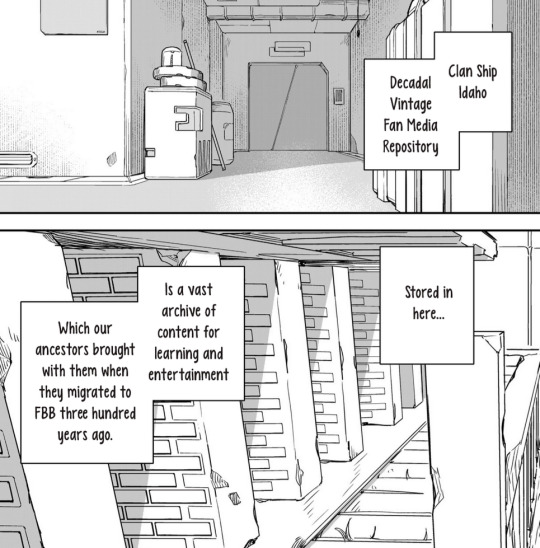
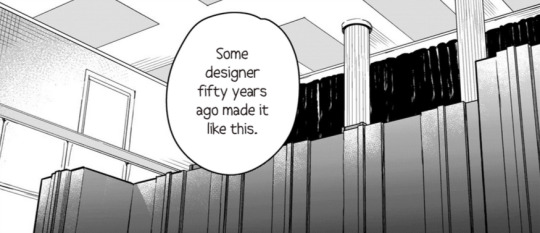
Anyway, I just had to gush a little bit about this chapter, in what is quickly becoming one of the manga releases I most anticipate reading every month.
52 notes
·
View notes